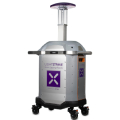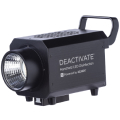A recent study adds to the volume of published evidence, further proving that not all UV products are the same when it comes to the efficacy or efficiency in killing certain pathogens. As an evidence-based company, the Xenex Science Team invests a significant amount of time evaluating the scientific literature — and we thought this one deserved further discussion. The study concluded: “UV-C disinfection did not reduce VRE or C. difficile infection rates in cancer and solid organ transplant units.”1
We’d like to take a moment to clarify two major points about this study:
- This study used mercury UVC devices (253.7 nm) and should not be generalized to all types of germicidal UV light. Xenex’s LightStrike room disinfection technology uses a pulsed xenon-based germicidal UV system that produces very different wavelengths of UV light (the entire germicidal spectrum from 200 to 280 nm) at much higher peak power (more than 4,000 times greater) than Mercury UVC devices. Because of these differences, the study’s conclusions cannot be generalized to germicidal technologies that are non-mercury based (Mercury bulbs are found in products such as R Zero, RD UVC Surfacide, Tru D, UVDI, etc.)
- The second major difference between what was observed in this paper and Lightstrike is the way the patented Lightstrike disinfection robots are used in hospitals. Our evidence-based protocols have been developed in partnership with hundreds of hospitals to most effectively provide environmental disinfection where and when it is needed. Our teams work closely with hospital EVS team members to develop unique protocols that meet the epidemiological and resource needs of our partner hospitals. This study used different protocols and therefore cannot be generalized.
We applaud the authors of the study for examining the impact of mercury UV light on patient outcomes. We encourage anyone to search this topic in PubMed (the NIH site where peer-reviewed scientific articles are cataloged) using terms such as “Pulsed xenon ultraviolet light”, “ultraviolet disinfection” and “no-touch disinfection”
For more information about published evidence on LightStrike technology, please contact our science team at science.resources@xenex.com.
References:
1. Rock C, Hsu Y-J, Curless MS, Carroll KC, Ross Howard T, Carson KA, et al. Ultraviolet-C Light Evaluation as Adjunct Disinfection to Remove Multidrug-Resistant Organisms. Clinical Infectious Diseases. 2021. doi:10.1093/cid/ciab896.
Author: Dr. Mark Stibich, Chief Scientific Officer & Founder, Xenex Disinfection Services

















